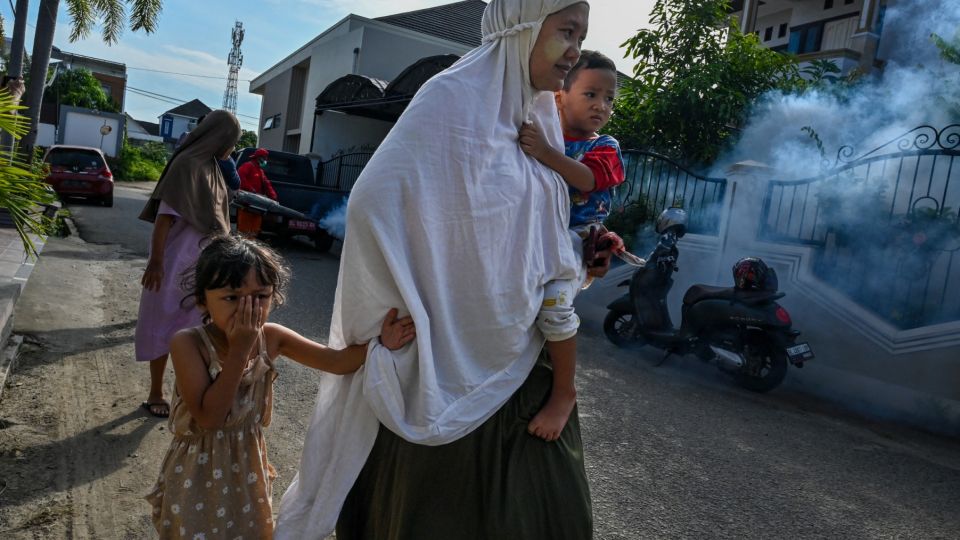September 10, 2025
BATAM – Dengue fever cases and deaths are on the rise in several regions across the country, with health officials warning that the ongoing wet-dry season weather anomaly is creating ideal breeding conditions for mosquitoes, the primary vector of the viral disease.
In Batam, Riau Islands province, health authorities have reported 499 dengue cases and two deaths this year until Sept. 1. That figure has surpassed the 329 total cases recorded in 2023, although it remains below the 871 cases reported last year.
Didi Kurmarjadi, head of the Batam Health Agency, said the city could soon declare a local dengue outbreak if the current trend continued.
“The Batam mayor has issued a circular urging residents to remain vigilant against dengue fever, particularly by adopting the 3M Plus strategy,” Didi said on Sept. 4, referring to the government’s prevention campaign.
Initially named 3M for “Menguras, Menutup dan Mengubur” (drain, cover and bury), the decades-long campaign is a strategy to reduce areas with stagnant water that serve as breeding grounds for mosquitoes.
In recent years, the campaign has been expanded to “3M Plus” with the addition of several measures, such as the use of insect repellent or wearing protective clothing to prevent mosquito bites, sprinkling larvicide to kill mosquito larvae, installing window screens, growing mosquito-repellent plants and even keeping fish that eat mosquito larvae.
Didi added that the Batam administration had also conducted fogging operations to kill adult mosquitoes, noting that fogging was not a long-term solution because it did not target mosquito larvae.
“What is most important is preventing mosquito breeding by keeping the environment clean,” he emphasized.
Read also: Jakarta administration warns of rising dengue fever cases
To support its ongoing dengue prevention effort, the city has called on communities to carry out cleanup activities at least once a week in a bid to disrupt the mosquito life cycle.
Mosquito larvae typically take nine to 10 days to develop into adults. Female mosquitoes that become infected with the dengue virus can transmit it to humans through their bites.
Other regions beyond Batam have recorded a similar spike in cases of dengue fever.
Aceh Singkil regency in Aceh province has reported 108 dengue cases since the beginning of the year, more than three times the 31 cases recorded over the same period in 2024.
Officials in Central Bangka regency, Bangka Belitung Islands, have signaled an alarming rise with as many as 200 dengue cases reported until July, a figure that matches last year’s total caseload.
The nationwide tally for the first half of the year stood at 67,000 dengue cases and 297 deaths, which translates into a case fatality rate (CFR) of 0.4 per 100,000 people.
According to the 2024 ASEAN Dengue Summit, Indonesia reported the highest number of cases in Southeast Asia and accounted for a staggering 66 percent of all dengue-related deaths in Asia. The country recorded more than 257,000 cases and 1,400 deaths in 2024.
The World Health Organization also noted that Indonesia was the leading contributor to dengue-related fatalities in Asia.
Health authorities have warned that the ongoing wet-dry season anomaly, marked by sporadic heavy rains during the supposed dry season, is creating ideal conditions for mosquitoes to breed, which in turn increases the risk of dengue fever outbreaks.
These brief but intense downpours are leaving behind pools of stagnant water, the prime breeding ground for Aedes aegypti mosquitoes.
The Meteorology, Climatology and Geophysics Agency (BMKG) has attributed this year’s unusual rainfall patterns to a weaker Australian monsoon, which normally ushers in the dry season across much of Indonesia. This has coincided with warmer-than-normal sea surface temperatures south of the archipelago, triggering continued rainfall across various regions.
The BMKG has forecast that these rainfall anomalies might persist through October, affecting areas including Greater Jakarta, West Java, East Java, East Kalimantan, South Sulawesi, West Nusa Tenggara, Maluku and Papua.
Climate experts have pointed to the anomalous rain pattern as a clear sign of climate change, driven by global warming, while the government has acknowledged that the country’s long-term trend in dengue cases is closely linked to the shifting climate.
Read also: Dengue, chikungunya may soon be endemic in Europe: research
Related changes in temperature, humidity and rainfall patterns have accelerated the life cycle of Aedes aegypti mosquitoes and expanded their geographic range, making dengue outbreaks more frequent and widespread.
Previous major dengue outbreaks in Indonesia occurred in 10-year cycles, but a new cycle of every three years has emerged in recent years, largely due to alternating El Niño and La Niña phenomena.


